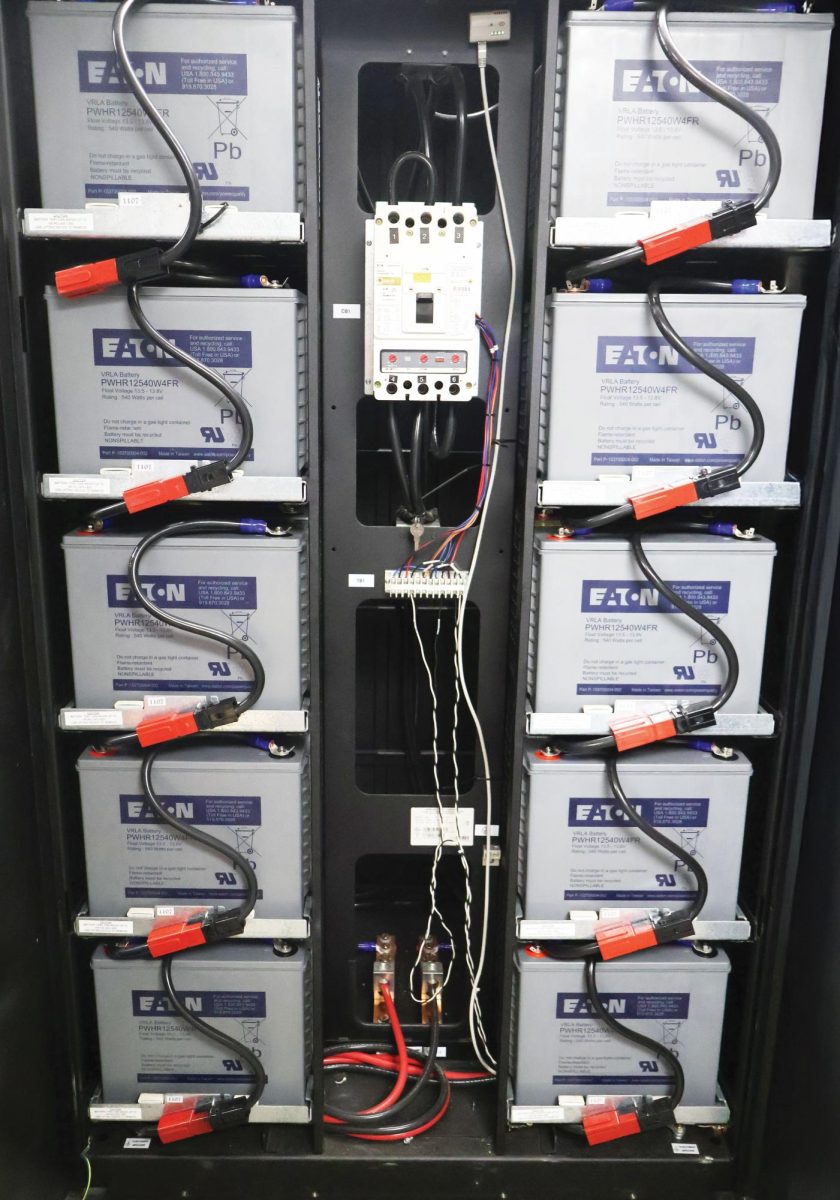One of three cabinets of backup batteries on campus in the Green Library to keep the school’s server running for roughly eight hours after blackouts, typically caused by inclement weather.
One moment, warmth and light. The next, darkness and cold.
The comforting whir of the heater stops mid-cycle.
Temperatures inside plummet, layering the dark windows with frost. The streetlight had gone out too.
Without power, the oven and microwave and everything else are useless. Dinner is a collection of dry snacks and cold leftovers.
Phones, tablets and laptops are rationed like survival tools, their batteries dwindling and slowly dropping.
For students, a power outage is not just discomfort, it’s a disruption. Due dates loom, but without power, even something as simple as turning in an assignment becomes a near impossibility.
For many others, it’s not just discomfort, it’s dangerous.
Between 2000 and 2023, Texas experienced 210 weather-related power outages, the highest in the nation during that period, according to the U.S. Department of Energy (DOE).
Of these outages included the Texas power crisis in 2021 that stretched from Feb. 10 to Feb. 27, leaving millions without power and several winter-related injuries.
For families like senior Nicholas Dickason’s who don’t own backup generators, these winter outages pose a huge logistical problem. Because Dickason’s neighbors live in a different grid than his family, when these storms knock out his power, he says that they need to relocate all of their groceries into houses that do have electricity.
“During that winter storm four years ago, we immediately had to book a hotel after moving stuff into my neighbors,” Dickason said. “It lasted for three to four days and was really inconvenient.”
Whenever a winter storm is forecasted, Director of the Physical Plant Mark Webb has to ensure that all essential heating and water units are functioning correctly.
“We go through to make sure we’ve got everything programmed properly for our HVAC (heating, ventilation and air conditioning) to run, to keep everything warm on the inside of the buildings,” Webb said. “As far as the exterior buildings, we go through and we winterize all the water systems that are outside.”
In response to the mass outages across Texas in 2021, the Electric Reliability Council of Texas (ERCOT) has implemented several measures to enhance grid reliability in Dallas.
A key improvement is the Weatherization and Inspections Program, which has completed 450 inspections on powergrides throughout Texas.
“Outages used to be more frequent for us a few years ago. I’d say we had at least two major ones every year,” Dickason said. “However, over the past 18 months, we’ve only experienced one outage, so things are definitely improving.”
But Dickason claims his family isn’t fully trusting better trends in their number of outages. Whenever bad weather is forecasted, Dickason says his family charges all of their devices, prepares portable chargers and makes sure flashlights and candles are always accessible.
“I remember once, I couldn’t turn in an essay because my laptop was dead, so I had to go to a friend’s house just to charge it,” Dickason said. “It was stressful trying to explain to my teacher that it was done, just that I couldn’t turn it in.”
Last May, the students and the school suffered an outage just as finals season kicked in. Because he didn’t have power, Dickason says he was worried about his science exams since he missed review days and didn’t have access to study materials.
To address the ongoing issue of power outages, the school has considered various backup solutions.
“Emergency generators are probably the best way for us to take care of the school’s needs in a situation where we do lose power,” Webb said. “But the school and all the powers have to be willing to buy in, and that’s a pretty hefty cost; it was pushing over a million dollars.”
During a power outage, the school has backup systems that can maintain the servers for a period of time, allowing students to connect from home.
“We do have backup battery power in our server rooms that will keep servers up,” Webb said. “So if you needed to tap into the school network from home, you could do that for a period of time. But if we lost power here, I would say after eight hours, we’d need to shut that down as well.”
The growing demand for energy on Texas infrastructure still places the systems under pressure, and they aren’t fully fail-proof. Between 2023 and 2024, Texas had the largest population increase according to the U.S. Census, making dependability all the more important.
“Texas has increased their reliability and done things to make sure that the Texas grid can take care of itself,” Webb said. “Of course, as time goes on, more people are moving to Texas, the strain on that grid is going to get heavier.”
But because of the effort Texas and the school are putting into ensuring electricity stays on even during the harshest of weather conditions, Dickason says he’s fairly optimistic about the future.
“I think as these storms become more frequent, we’ll be better prepared as a community,” Dickason said. “Instead of being caught off guard every year, we’ll eventually have systems in place, where we’ll have less and less outages.”









